Part I: Introduction
Chapter 1: Key Concepts
Katie Nelson and Nadine T. Fernandez
Learning Objectives
- Distinguish among the concepts of sex, gender, and sexuality.
- Articulate how gender is shaped by culture.
- Identify examples of nonbinary gender expressions.
- Discuss how gender is relational and the importance of understanding masculinity in relation to other gender expressions.
In this textbook we will explore the meanings and experiences of sex and gender from a global perspective. Let’s start by posing a basic question: why learn about sex and gender globally? Don’t we all know what it means to be a man or a woman? While the answer to that question may seem obvious, in fact, when we learn about gender and sexuality cross-culturally, it becomes clear that these are extremely complicated concepts. Ideas about gender and sexuality differ tremendously across different cultures. To make sense of this complexity, this chapter will introduce some key ideas, such as sex, gender, sexual orientation, gender ideologies, and masculinity.
What is Culture and Why Anthropology?
Given the fact that we want to learn more about sex and gender from a global perspective, the next question we might ask ourselves is: how will we learn more? We could learn more by reading the literature of different peoples, in different languages, to better understand how they tell stories about their lives and the ways in which people become men, women, or something more in their own cultures. Alternatively, we could take a legal approach and search historical records to learn how laws determined proper gender and sexual behaviors and how people were punished for particular crimes relating to sex and gender. For example, in the United States there have been laws against cross-dressing (men wearing women’s clothing, and vice versa), or miscegenation (interracial marriage, or interracial sex). Another option, and the one that we have chosen for this book, is to employ the discipline of cultural anthropology to help us learn about sex and gender from a global perspective.
What is Anthropology?
In the most general terms, anthropology refers to the study of humans. It is a holistic field of study that focuses on the wide breadth of what makes us human: from human societies and cultures to past human lifeways, human language and evolution, and even nonhuman primates. In the United States, anthropology is divided into four subfields: cultural anthropology, archaeology, biological anthropology, and linguistic anthropology. Applied anthropology uses the methods and knowledge of these subfields to solve real-world problems faced by different societies and cultures.
Anthropologists are not the only scholars to focus on the human condition. Biologists, sociologists, psychologists, and others also examine human nature and societies. However, anthropologists uniquely draw on four key approaches to their research: holism, comparison, dynamism, and fieldwork. For a more detailed introduction to anthropology, see chapter 1, “Introduction to Anthropology” in Perspectives: An Open Invitation to Cultural Anthropology: http://perspectives.americananthro.org/ .
For anthropologists, culture is defined as “a set of beliefs, practices, and symbols that are learned and shared. Together, they form an all-encompassing, integrated whole that binds people together and shapes their worldview and lifeways” (Nelson 2020). These beliefs, traditions, and customs, transmitted through learning, guide the behavior of a people as well as how they think about the world and perceive others. Anthropologists seek to understand the internal logic of a culture and why things that may seem “strange” or “exotic” to us make sense to the people of another culture. As such, anthropology is fundamentally comparative. That is, anthropologists seek to describe, analyze, interpret, and explain social and cultural differences and similarities. In doing so, we often turn a critical eye on our own practices and beliefs to understand them in a different way. We often learn and become more conscious of our own culture when we experience or study other cultures. Thus, North Americans traveling in China or in Europe often become more aware of their own “Americanness”—they become aware of aspects of their own culture and lifestyle that they often took for granted. These cultural characteristics stand out in sharp relief against their experiences in a foreign country.
What Is Culture?
Culture is a set of beliefs, practices, and symbols that are learned and shared. Together, they form an all-encompassing, integrated whole that binds groups of people together and shapes their worldview and lifeways. Additionally:
- Humans are born with the capacity to learn the culture of any social group. We learn culture both directly and indirectly.
- Culture changes in response to both internal and external factors.
- Humans are not bound by culture; they have the capacity to conform to it or not and sometimes change it.
- Culture is symbolic; individuals create and share the meanings of symbols within their group or society.
- The degree to which humans rely on culture distinguishes us from other animals and shapes our evolution.
- Human culture and biology are interrelated: our biology, growth, and development are impacted by culture.
We will be reading chapters created by cultural anthropologists who have conducted extensive fieldwork or ethnography in the country and culture they are writing about. The term ethnography refers both to the books written by anthropologists and to their research processes or fieldwork. So cultural anthropologists gather information through long-term fieldwork by participating in a particular culture over time. Fieldwork is primarily a qualitative research method and involves living among the people you are studying. Over time anthropologists collect information or data about a particular group of people through formal and informal interviews and observations they record in field notes.
Throughout this book we will be exploring a lot of practices that some of us may find “strange” or “unnatural.” It is essential that we try to approach these subjects as anthropologists would. That is, to understand these practices from what the famous anthropologist Bronislaw Malinowski called, “the native’s point of view.” In other words, our goal is to try to learn about and understand the perspective of the people who engage in these particular practices and beliefs. Anthropologists call this type of approach cultural relativism. Cultural relativism is the position that the values and standards of cultures differ and deserve respect, and it is a core value of anthropology. Cultural relativism is a particularly useful perspective in anthropology because without understanding a culture from an insider’s perspective, we can never fully understand how and why people do what they do. In essence, without cultural relativism, an accurate study of humanity is not possible.
In contrast to cultural relativism, ethnocentrism refers to the tendency to view one’s own culture as the best and to judge the behavior and beliefs of culturally different people by one’s own standards. All cultures tend to be ethnocentric, so it is not only Western, industrialized cultures that think their way of living is the best. In this course, we will all have to work hard to try to put aside our ethnocentrism as we explore meanings and practices of sex and gender across other cultures.
Check out the video titled “Anthropology Syllabus,” by the anthropologist Michael Wesch from Kansas State University. In the video, Dr. Wesch introduces the syllabus he has created for an Introduction to Anthropology course. In it, he describes the nine big ideas of anthropology; they make up the outline of the syllabus he has created. It’s a great introduction to anthropology, to the ideas of cultural construction, and to the assumptions we all carry within us that create ethnocentrism. The video is a testament to how important it is for us to understand how we—humans—make the world we live in.
What Is Sex?
In general in the United States today, people often use the terms sex and gender interchangeably. This is incorrect and leads to a lot of confusion. So first we will define these concepts (and other related ones) so that the terms used in this text are clear.
In the United States, as in other parts of the world, sex is generally understood to be the biological component that marks people as either male or female. Many believe that sex is a fixed characteristic that is determined at birth and can always be easily defined and determined. One way people define sex is by examining the genitalia of a person. For instance, expectant parents often use ultrasounds to get an educated guess of the sex of their baby before it is born (see figure 1.1). Chromosomes provide more definitive evidence, as fetuses or infants typically exhibit an XX or XY chromosomal combination. However, it is important to understand that there are more genetic combinations possible than simply XX or XY, and sometimes genitals are not clearly defined at birth. Intersex people (once referred to by the derogatory term hermaphrodites) may display ambiguous genitalia or possess a different chromosomal combination, such as XXY. Intersex people have been born in all societies throughout time. It is estimated that approximately 1.7 percent of the world population is intersex (Fausto-Sterling 2000).
In some societies, intersex people are revered as sacred and take on special roles in the community. In others, such as the United States, they have historically been seen as “deviant” and are often surgically “assigned” a sex shortly after birth. However, starting in the 1990s in the United States this practice has been increasingly challenged. Many parents now refrain from assigning a sex to intersex children at birth, allowing the child to later determine their own sex and gender identities instead.

Another way that people determine sex is by studying hormone levels and traits that develop in puberty. Sex-linked hormones such as testosterone and estrogen are excreted by both men and women and are responsible for the development of secondary sex characteristics such as height, muscle mass, and body fat distribution. However, these characteristics are not always clearly defined. For instance, many biologically “normal” women have higher muscle mass than some men and many biologically “normal” men are shorter than some women. And while it is generally understood that men excrete more testosterone than women and women more estrogen, recent research is changing our understanding of human hormone physiology. For instance, some studies have shown that the levels of testosterone can rise in women as a result of wielding power in social situations, regardless of whether it is done in stereotypically masculine or feminine ways (van Anders 2015). Thus, it’s becoming clear that testosterone and estrogen are not biologically fixed but that gender socialization may affect their excretion by encouraging or discouraging people toward behaviors that can modify their physiology.
There are also conditions in which a person’s sex can change throughout their lives. For instance, there are documented cases including the Guevedoce of the Dominican Republic in which some children (about 1 percent of the population) look like girls at birth, with no testes and what appears to be a vagina. They are subsequently socialized as girls during childhood. However, during puberty, when hormone levels rise, they begin to grow a penis, their testicles descend, they develop a “masculine” physique, and they are frequently then seen as male (Imperato-McGinley 1975). In sum, while sex may refer to biology, it is not easily defined by the binary opposition between “male” and “female.” There are actually additional complexities to consider.
What Is Sexuality?
As we have discussed, sex refers to the biological basis (male/female/intersex) for gender (man/woman/trans/third gender). Just as gender is not inextricably linked to sex, sexuality is experienced independently of both. In short, sexuality refers to “what we find erotic and how we take pleasure in our bodies” (Stryker 2008, 33). Like gender, sexuality and sexual practices vary from culture to culture and across time and so must also be considered socially constructed.
Sexual orientation refers to the ways in which we seek out erotic pleasure or how our sexuality is “oriented” toward particular types of people. Thus, heterosexuality refers to an orientation toward pleasure that takes place between men and women, while homosexuality refers to erotic pleasure between men or between women. Bisexuality refers to an orientation that includes both men and women, while asexuality refers to the absence of a desire or sexual orientation toward other people. However, this is not to say that these are the only ways people experience sexuality. Many anthropological studies describe same-sex practices in societies that otherwise strongly value heterosexual marriage and fertility. In such contexts, sexuality is not so much an identity as it is a ritual, life stage, coping technique, or form of pleasure. Though sometimes shielded from public view, same-sex relations are sometimes seen as complementary to heterosexual relations in some cultural contexts, fully compatible with cultural demands for heterosexual marriage and family life. In his research on gender and sexuality in Nicaragua, for instance, Roger Lancaster (1992) found that conventionally masculine men could maintain their essentially heterosexual identities if they took the “active,” penetrative role in same-sex encounters. In sum, anthropological research demonstrates that humans express their sexuality in a wide variety of ways that are shaped by cultural factors, and change over time.
What Is Gender?
While sex refers to one’s biology (male, female, intersex), gender refers to a person’s internal identity as “masculine,” “feminine,” or some combination thereof. Gender is also something that is publicly expressed and shaped by culturally acceptable ways of being “male” or “female.” People tend to internalize and naturalize these expectations in ways that make gender categories seem “natural” and normal (Mukhopadhyay and Blumenfield 2020). In fact, the ways that people, things, actions, places, spaces, etc. are gendered sometimes seem invisible to people, even though they are central to the ways that society is organized.
For instance, consider the following thought experiment (Mukhopadhyay and Blumenfield 2020). Think about the ways that your day is organized by your gender. Consider, first, how you woke up this morning and started your day. What was the pattern of your bedsheets and the color of your toothbrush? Do these reveal something about your gender identity? What do the bottles of shampoo and body soap you used in the shower look like? What does your deodorant smell like? Do these reflect your gender? What style of clothing did you choose to wear today? Did you apply any skin treatments or makeup? Did you apply a perfume/cologne? What does the scent say about your gender? Once you left your home, how did you move your body and walk and talk to others? What was the tone of your voice like, and what were the choices of words you spoke? What do these actions say about your gender? Do they conform with societal expectations, or do they defy them in some ways? Do you think conforming to or defying these expectations make your life easier or more difficult?

As you can see, gender is a pervasive social category that impacts people’s lives in multiple and intimate ways. Studies of gender teach us that the categories of “man” and “woman,” which we often think of as being “natural” categories, are in fact cultural constructs. That is, they are ways of being, doing, and even performing one’s identity that are shaped by a particular culture and often based on the biological labels assigned to us. As children, we begin to learn gender ideologies from the moment we are born, and a small blue or pink hat is placed on our head. As babies, our gender label can impact the way our caregivers interact with us. As we grow, we learn the “correct” and “normal” ways to behave based on the category we are assigned to (“boy” or “girl”) and then the toys we are given, the advertisements we see, the activities we engage in, and so on (see figure 1.2).
EXPLORE: Watch this video (https://vimeo.com/209451071) by Anne Fausto-Sterling, which elaborates on how gender is formed in childhood and how it can change throughout one’s life.
For anthropologists, the comparative method—contrasting certain cultural elements cross-culturally—helps us see how categories like “male” and “female” are not universal but are cultural constructions. Categories, actions and practices that we assume are “natural” are not necessarily found in all cultures. Thus, by studying other cultures we not only learn about the obvious differences in cuisine, language, and dress, but also the differences in genders and sexualities.
As complex as sex, gender, and sexuality can be, it is helpful to have a diagram illustrating the possible relationships among these factors. Activist Sam Killermann has developed a useful diagram known as “The Genderbread Person,” depicting the various aspects of identity, attraction, expression, and physical characteristics that combine in the gender/sexuality of whole persons.
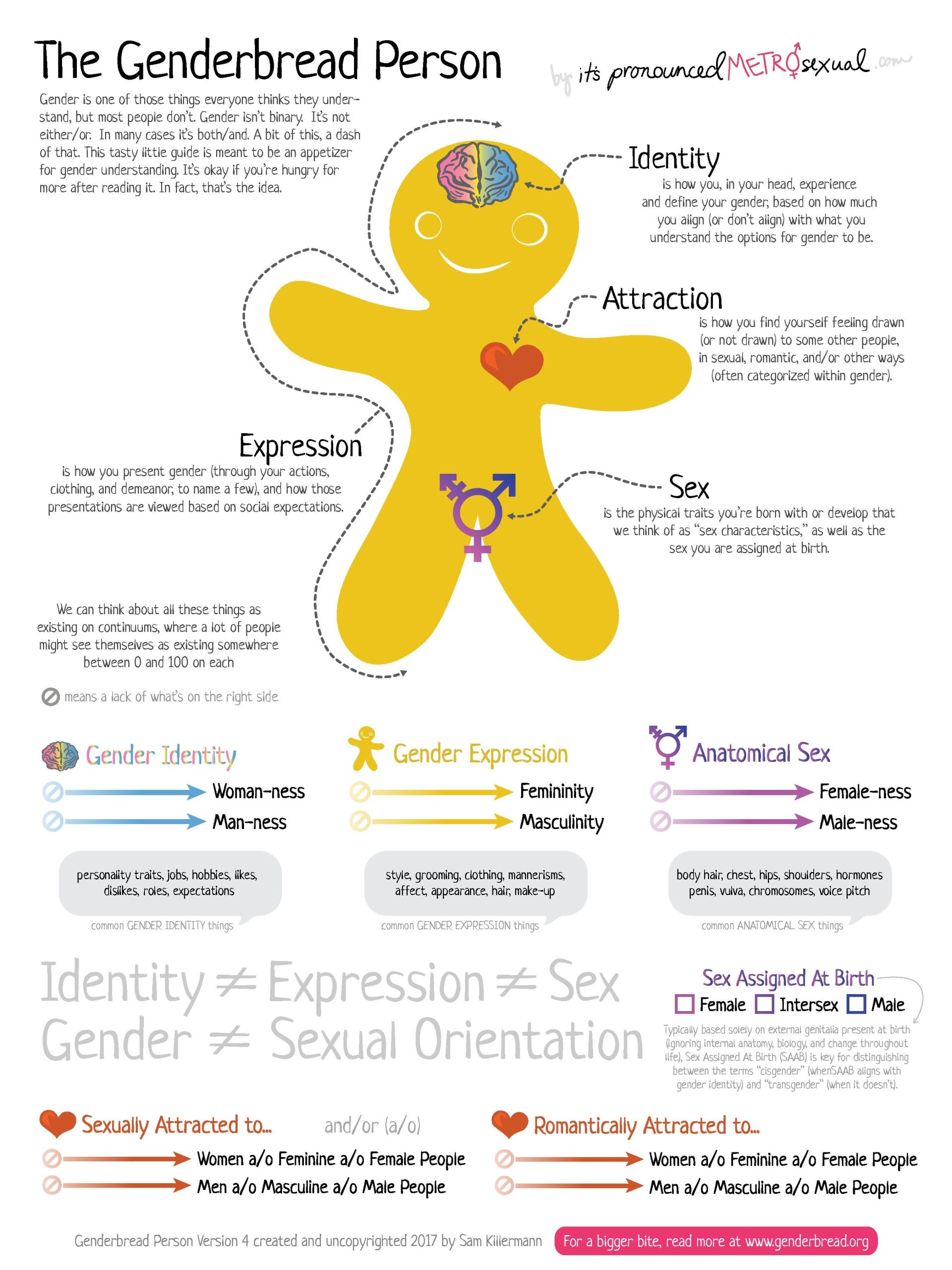


EXPLORE: Take a look at Dr. Wesch’s video on “The Matrix & the Social Construction of Reality” (https://www.youtube.com/watch?v=rukdvq8v8So). In it, he tries to teach and learn from his young son about social constructionism.
Gender Ideologies
A gender ideology is a coordinated set of ideas about gender categories, relations, behaviors, norms, and ideals. These ideas are embedded in the institutions of the family, the economy, politics, religion, and other sociocultural spheres. As with racial and class ideologies, people often challenge the explicit terms of a gender ideology while actively participating in the institutionalized forms associated with it. Though women have made great strides in American public life in past decades, in their weddings, they still enact a gender ideology that positions them as dependent objects passed between men in the transaction of marriage. The power of gender ideology is that it most frequently operates below the level of consciousness. As you will recall from previous discussions of the term, an ideology that becomes naturalized as “common sense” becomes hegemonic.
Patriarchy is a widespread gender ideology that positions men as rulers of private and public life. Within the household, the eldest male is recognized as head of the family, organizing the activities of dependent women and children and governing their behavior. Family resources such as money and land are controlled by senior men. Men make decisions; women acquiesce. Beyond the family, men are accorded positions of leadership throughout society, and women are summoned to play a supportive and enabling role as marginalized subordinates.
Contemporary forms of patriarchy in American and European contexts are linked to the European development of capitalism in the 1600s. As economic activities moved out of households and into factories and offices, the household came to be defined as a private sphere, while the world of economic and political activities came to be called the public sphere. Women were assigned to the private sphere of family life, where they were expected to carry out nurturing roles as wives and mothers. Men not only governed the private sphere but also participated in the competitive and sometimes dangerous public sphere.
As the term suggests, matriarchy means rule by senior women. In a matriarchal society, women would exercise authority throughout social life and control power and wealth. Like patriarchy, matriarchy is a gender ideology. Unlike patriarchy, however, matriarchy is not embedded in structures and institutions in any culture in the contemporary world. That is to say, it’s just an ideology—not a dominant one, and certainly not hegemonic.
While societies with patrilineal kinship systems are strongly patriarchal, societies with matrilineal kinship systems are not matriarchal. This is a common source of confusion. In matrilineal kinship systems, children primarily belong to their mother’s kin group, and inheritance passes through the maternal line. However, even in matrilineal societies, leadership is exercised by the senior men of the family. Instead of a woman’s husband, it is often her brother or mother’s brother (her maternal uncle) who makes decisions about family resources and disciplines the behavior of family members.
Contemporary anthropologists who study gender pay little attention to hypothetical debates about the origins of patriarchy or the possible existence of ancient matriarchy. Rather, cultural anthropologists are interested in how people interact with the cultural norms and systematized practices of gender in their societies. Gender is diffused throughout culture, embedded in systems of kinship, modes of subsistence, political leadership and participation, law, religion, and medicine. Anthropologists study how people move through these gendered realms in their everyday lives. They explore how identities and possibilities are shaped by the structures of gender as well as how people struggle against and sometimes transform gendered expectations. Throughout this book you will read about various historical constructions of gender ideologies in different parts of the world. In particular, you will explore how the systems of colonialism profoundly shaped gender ideologies in places like Latin America and South Asia and how these gender ideologies continue to change.
Throughout this book you will read about various historical constructions of gender ideologies in different parts of the world. In particular, you will explore how the systems of colonialism profoundly shaped gender ideologies in places like Latin America and South Asia and how these gender ideologies continue to change.
Human Sex Differences: Biology and Behavior
Just as with primate research, research on human biological sex/gender differences has been considerably slanted by the gender bias of the (often male) researchers. Within the Euro-American intellectual tradition, scholars in the past have argued that women’s biological constitution makes them unfit to vote, go to college, compete in the job market, or hold political office. More recently, beliefs about the different cognitive abilities of men and women have become widespread. Males are supposedly better at math and spatial relationships, while females are better at language skills. Hormonal activities supposedly make males more aggressive and females more emotional.
In her book Myths of Gender, biologist Anne Fausto-Sterling (1992) conducts a massive review of research on cognitive and behavioral sex/gender differences in humans. Looking very closely at the data, she finds that the vast number of studies show no statistically significant difference whatsoever between the cognitive abilities of boys and girls. A minority of studies found very small differences. For instance, among four studies of abstract reasoning abilities, one study indicated that females were superior in this skill, one study indicated that males were superior, and two studies showed no difference at all. Overall, when differences are found in verbal abilities, girls usually come out ahead, but the difference is so small as to be irrelevant to questions of education and employment. Likewise, more than half of all studies on spatial abilities find no difference between girls and boys. When differences are found, boys come out ahead, but the difference is again very small. Looking at the overall variation of skill levels in this area, only about 5 percent of it can be attributed to gender. This means that 95 percent of the differences are due to other factors, such as educational opportunities.
Even these tiny differences that may exist in the cognitive talents of different genders are not necessarily rooted in biological sex differences. Several studies of spatial abilities have shown that boys may initially perform better on spatial ability tests, but when given time to practice, girls increase their skill levels to become equal to boys, while boys remain the same. Some researchers reason that styles of play such as sports, often encouraged more by parents of boys, may build children’s spatial skills. Parenting styles, forms of play, and gender roles—all elements of culture—may shape the data more than biology. Cross-cultural studies also indicate that culture plays an important role in shaping abilities. A study of the Inuit found no differences at all in the spatial abilities of boys and girls, while in a study of the Temne of Sierra Leone, boys outperformed the girls. Inuit girls are generally allowed more freedom and autonomy, while Temne girls are more restricted in their activities.
Similar complexities emerge in the analysis of studies on aggression. Fausto-Sterling found that most studies revealed no clear relationship between testosterone levels and levels of aggression in males. Moreover, testosterone aggression studies have been riddled with problems such as poor methodology, questionable definitions of aggression, and an inability to prove whether testosterone provokes aggression or the other way around. Where differences in aggression between girls and boys are documented, some researchers have concluded that cultural factors may play a strong role in producing those differences. Anthropologist Carol Ember studied levels of aggression among boys and girls in a village in Kenya. Overall, the boys exhibited more aggressive behavior, but there were exceptions. In families lacking girl children, boys were made to perform more “feminine” work such as childcare, housework, and fetching water. Boys who regularly performed those tasks exhibited less aggression than other boys—up to 60 percent less for boys who performed a lot of this work.
As with the primate research on sex differences, research on the brains, bodies, and behaviors of male and female humans does not seem to suggest that significant behavioral differences are biologically hardwired. While researchers have discovered differences in the cognitive talents and social behaviors of males and females, those differences are very small and could very well be due to social and cultural factors rather than biology. As with bonobos and chimpanzees, humans are biologically quite flexible, allowing for a diverse array of forms of gender and sexuality.
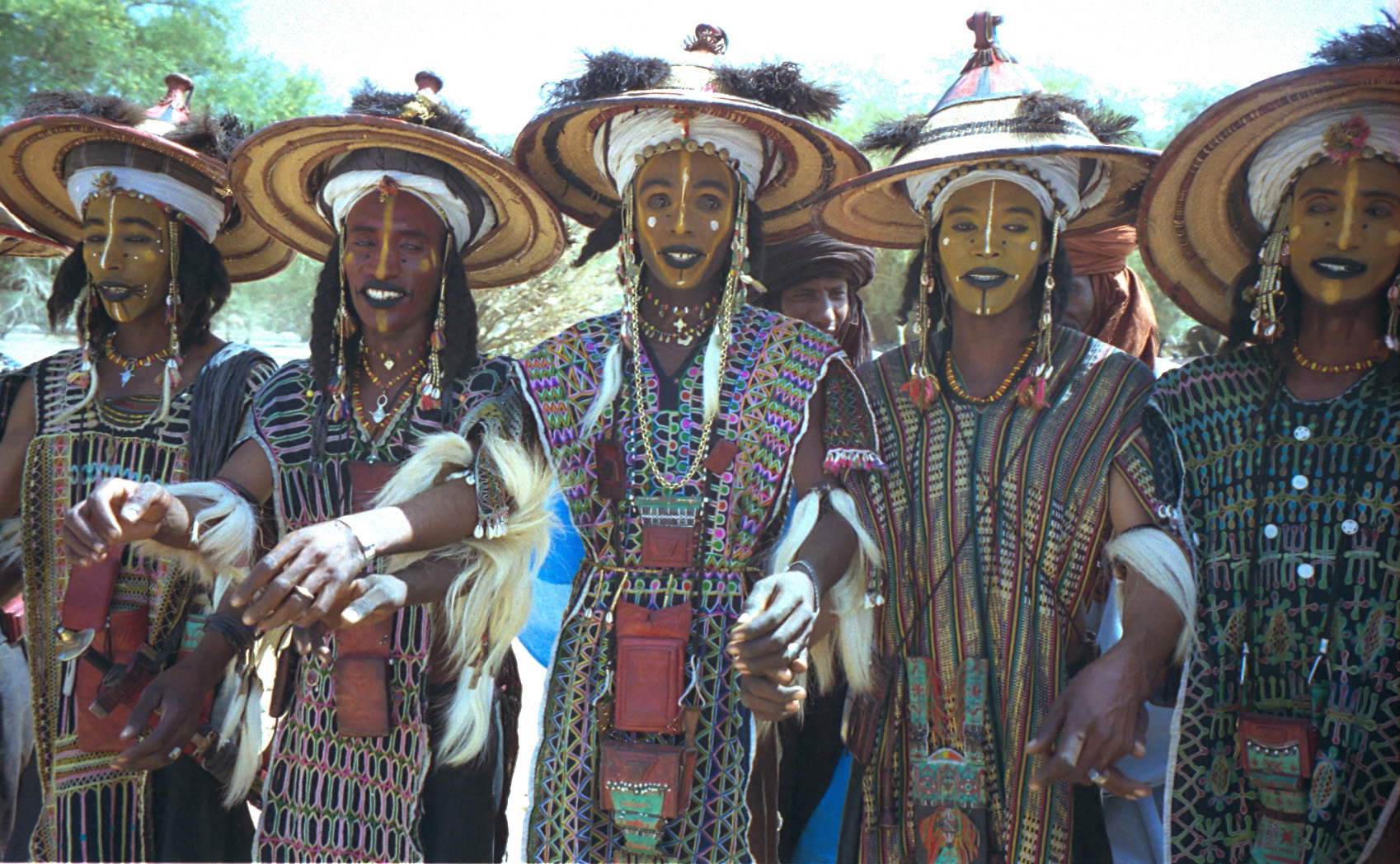
Cultural anthropologist Margaret Mead conduced research on gender in several societies in New Guinea. She confessed that she had initially assumed that that gendered behaviors were grounded in biological differences and would vary only slightly across cultures. In her 1935 book, Sex and Temperament, she describes her surprise at discovering three cultural groups with vastly different interpretations of gender. Among the Arapesh and Mundugumor, men and women were considered temperamentally quite similar, with little acknowledgement of emotional or behavioral differences between them. The Arapesh valued cooperation and gentleness, expecting everyone to show tolerance and support for younger and weaker members of the group. In contrast, among the Mundugumor, both men and women were expected to be competitive, aggressive, and violent. Among the Tchambuli (or Chambri), however, men and women were assumed to be temperamentally different: men were seen to be neurotic and superficial, while women were thought of as relaxed, happy, and powerful. While Mead’s dramatic findings have been subject to criticism, subsequent analysis and fieldwork by other anthropologists have largely substantiated her main conclusions (Lipset 2003). Likewise, behaviors such as using makeup are not solely the domain of women in all cultures (see figure 1.4).
In the 1950s, a time when American men were supposed to be breadwinners and American women were urged to be housewives and mothers, most primatologists believed that males were the public actors in primate social life, while females were passive, marginal figures. Primatologists of the time believed that males constantly competed against one another for dominance in a rigid group hierarchy, while females were more narrowly interested in raising young (Fedigan and Fedigan 1989). In fact, primatologists described the total social organization of primates in terms of male competition. This view went along with Charles Darwin’s notion that males are forced to compete for the opportunity to mate with females and so, therefore, must be assertive and dominant. Females, in Darwin’s theory, were shaped by evolution to choose the strongest male to mate with and then concern themselves exclusively with nurturing their offspring to adulthood.
By the 1980s, however, a number of strong studies were showing some very surprising things about primate social organization. First, most primate groups are essentially composed of related females, with males as temporary members who often move between groups. The heart of primate society, then, is not a set of competitive males but a set of closely bonded mothers and their young. Females are not marginal figures but central actors in most social life. The glue that holds most primate groups together is not male competition but female kinship and solidarity.
Second, social organization in primates turned out to be incredibly complex, with both males and females actively strategizing for desirable resources, roles, and relationships. Research on a number of primate species has demonstrated that females are often sexually assertive and highly competitive. Female primates actively exercise their preference to mate with certain male “friends” rather than aggressive or dominant males. For males, friendliness with females may be a much better reproductive strategy than fighting with other males. Moreover, many primatologists have begun to identify cooperation rather than competition as the central feature of primate social life while still recognizing competition for resources by both males and females in their pursuit of survival and reproduction (Fedigan and Fedigan 1989).
What this means, in a nutshell, is that (1) both females and males are competitive, (2) both females and males are cooperative, and (3) both females and males are central actors in primate social life.
Research among primates as well as other lines of research are helping us better understand the complex relationship between behavior and biology among male and female primates, including humans. Ongoing research in a variety of disciplines shows that even the biological differences between men and women are less pronounced than we believed previously. For instance, research on human parental care has shown that when caring for infants, men excrete equal amounts of hormones oxytocin and prolactin as women do when they go through childbirth and lactation (Gordon 2010). These hormones play an important role in bonding with infants and encourage positive care behaviors, demonstrating that, biologically, men can be equally sensitive to the needs of infants as women.
Like many other primates, humans show a degree of sexual dimorphism, or differences in stature, musculature, and skeletal robustness between males and females, although much less than other primates (see figure 1.5). Yet there is also a lot of variability among males and females. For instance, some females are taller than some males, and some males have more body fat than some females. Research on cross-cultural gender norms, human biology, primatology among others, demonstrates that these differences do not dictate behaviors nor predict abilities in individuals. The relationship between human biology and behavior is much more complex than we ever knew and strongly influenced by culture. In anthropology, looking at the ways in which our biology influences our culture—and how our culture influences our biology—is called the “biocultural” approach and is an exciting and growing area of research.
- (male)
- (female)
- (male)
- (female) Figure 1.5a–d. Many non-human primates such as gorillas display much more sexual dimorphism than humans. You can see the differences in size and robustness in the male gorilla compared to the female gorilla. These differences are much less noticeable among humans where the female skull is nearly the same size as the male skull. Henri et George/Shutterstock; Randall Reed/Shutterstock; uzuri/Shutterstock; ivanpavlisko/Shutterstock.
Multiple Gender and Variant Gender
Many societies construct additional categories between male and female to accommodate people who do not fit into a binary gender system. The term multiple gender indicates a gender system that goes beyond male and female, adding one or more categories of variant gender to accommodate more sex/gender diversity. A variant gender is an added version of male or female that accommodates those who were not assigned to that category at birth but adopt that identity during the course of their lives. A person whose biology, identity, or sexual orientation contradicts their assigned sex/gender role can adopt a variant-gender identity. For instance, a person might be considered female at birth but later transition to a masculine version of female—what anthropologists term female variant.
Cultural anthropologist Serena Nanda (2000) has studied variant-gender categories in many societies, including Native North American societies and peoples in Brazil, India, Polynesia, Thailand, and the Philippines. Hijras in India, which will be discussed in greater detail in chapter 5 of this book (see figure 1.9), are often called a ‘third-gender’ group. Burrnesha, or “sworn virgins” in Albania are another example of a third gender. In traditionally patriarchal parts of Albanian society, gender roles are strict and place substantial limitations on women. Sworn virgins are women who renounce sexual relations completely to become honorary men, taking on the role of the man in their household and community; they dress, act, and are treated as men (enjoying the relative freedoms of men as well) (see figure 1.7). The widespread practice of multiple gender indicates a common cultural need to accommodate the complexities of human sex/gender and sexuality. In contrast, European and Euro-American societies have inherited a rigid two-gender system that stigmatizes people who do not conform to the gender identity assigned to them at birth. Activists pressing for more gender flexibility can be inspired by examples of alternative gender in many non-European cultures.
When Spanish explorers first came to North America, they were astonished to find men in Native American societies who dressed as women, did the work of women, and had sexual relationships with men. Later, anthropologists who studied Native American groups discovered that some groups, including the Crow and the Navajo, had categories of variant male (assigned a male identity at birth but adopting a feminine identity later on) and variant female (assigned female at birth but adopting a masculine identity later on). Note that people in variant categories did not fully transition to the opposite gender but rather took on a masculine or feminine variant of the sex assigned at birth. Ignoring the Native American terms for variant gender, early European explorers referred to variant males as berdache, a Portuguese term that indicated a male prostitute—though that is not what they were at all. In 1990, as Native American LGBTQ people sought to resurrect their heritage of variant gender, they coined the pan-Indian term two-spirit people, meaning people with both male and female spirits.
Two-spirit people were highly valued and esteemed in Native cultures. Rather than facing stigma or rejection, their alternate gender identity was thought to give them special talents and spiritual powers. In many Native American societies, two-spirit people often became healers and spiritual leaders. They were typically very successful at performing the work of the opposite gender. Male-variant people were known for their excellent cooking and needlework, and many female-variant people were great hunters and warriors. Two-spirit people were also called upon to act as intermediaries between genders, such as in marriage arrangements.
Like gender-nonconforming people in many societies, two-spirit people began to realize their variant identities in childhood, rejecting the activities associated with their assigned gender. A boy might want to cook or weave, or a girl might prefer to hunt and play with the boys. If there were not enough boys to hunt, a family might even encourage a girl to develop a variant identity so that she could help provide meat to the family. Sometimes, children would experience visions or dreams guiding them to the tools associated with the opposite gender.
Generally speaking, people of variant gender had sexual relationships with people of the gender opposite their lived identity. So if a person took on the clothing and work of a woman, they would be expected to have intimate relationships with men, and people who lived as men would have relationships with women. Neither two-spirit people nor their opposite-gender partners were considered lesbian or gay.
With European colonization of North America came a much more restrictive system of gender categories and sexualities. As Euro-Americans expanded into Native American territories, Native Americans were pressured to assimilate to Euro-American norms. From 1860 to 1978, children were removed from their families and sent to assimilationist schools, where they were taught that Native cultures were backward and variant genders were sinful and deviant. By the 1930s, variant-gender practices had largely disappeared. However, with the rise of the American LGBTQ movement, many Native Americans have rediscovered the more flexible and tolerant gender system of their ancestors.
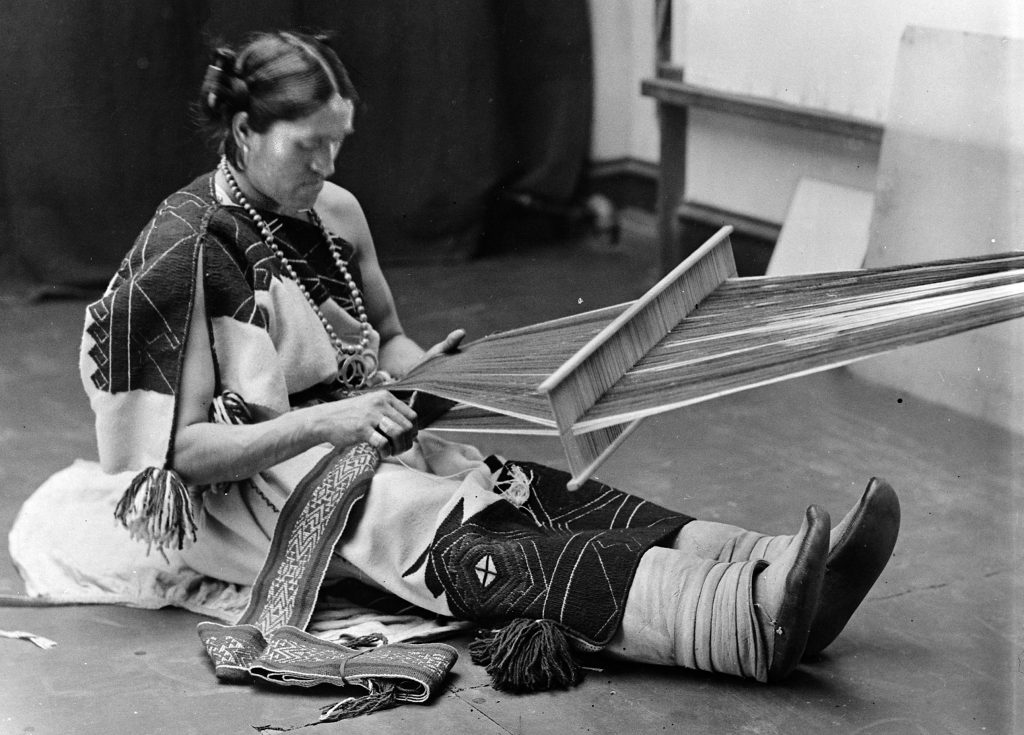
 Figure 1.7. In Albania, Burrnesha or “sworn virgins” are women who become honorary men, taking on the role of men in their community; they dress, act, and are treated like men. © 2011 Jill Peters.
Figure 1.7. In Albania, Burrnesha or “sworn virgins” are women who become honorary men, taking on the role of men in their community; they dress, act, and are treated like men. © 2011 Jill Peters.
Intersex and the Ambiguities of Identity
A friend tells you, “My sister just had a baby last night!” You respond, “Is it a boy or a girl?” Your friend replies, “Well, they don’t know. Maybe neither, maybe both.”
Based on a detailed analysis of extensive data, Anne Fausto-Sterling (2000) concluded that in about 1.7 percent of births, a baby’s sex cannot be completely determined just by glancing at the baby’s genitalia. (Note that due to different or changing considerations of sex determination, you may see different percentages or other differences in information; this text is using the most widely accepted and adopted research.) Intersex is an umbrella term for people who have one or more of a range of variations in sex characteristics or chromosomal patterns that do not fit the typical conceptions of male or female; the prefix inter- means “between” and refers here to an apparent biological state “between” male and female. There are many causal factors that can make a person intersex. Genetically, the baby may have a different number of sex chromosomes. Rather than two X chromosomes (associated with females) or one X and one Y chromosome (associated with males), babies are sometimes born with an alternative number of sex chromosomes, such as XO (only one chromosome) or XXY (three chromosomes). In other cases, hormonal activity or even chance occurrences in the womb can affect the baby’s anatomy.
While it is true that the majority of humans display biological characteristics associated with either one sex or another, 1.7 percent is not insignificant. If that percentage were applied to the global total of about 140 million babies born every year, it would mean that that more than two million of these babies could be intersex. On a more local level, if that percentage were applied to any town of 300,000 people, there could be more than 5,000 intersex people.
Beyond biology, the category of intersex reveals a great deal about the cultural mechanisms of gender. Intersexuality can be recognized at any point in a person’s life, from infancy to well into adulthood. Parents often discover their child is intersex in a medical context, such as at birth or during a subsequent visit to the pediatrician. When a doctor explains that a child is intersex, parents may be confused and concerned. Some doctors who are uncomfortable with biological sex ambiguity may order tests to determine the child’s chromosomal count and hormone levels and take measurements of the child’s genitals. They may urge parents to assign a specific gender to the baby and commit to plans for hormonal treatments and surgical interventions to affix that assigned gender to the growing child. Doctors are often taught to present the chosen gender as the “real” underlying sex of the baby, making medical treatment a process of allowing the baby’s “natural” (meaning unambiguous) sex to emerge. This conceptualization of intersex babies as “really” either male or female contradicts the complex mix of male and female traits presented by most intersex bodies (Fausto-Sterling 2000).
Fausto-Sterling disagrees with the practice of immediately affixing a sex to intersex babies through medical interventions. She argues that gender identity emerges in a complex interplay between biology and culture that cannot be assigned or controlled by doctors or parents. In an interview with the New York Times, she explained her position:
The doctors often guess wrong. They might say, “We think this infant should be a female because the sexual organ it has is small.” Then, they go and remove the penis and the testes. Years later, the kid says, “I’m a boy, and that’s what I want to be, and I don’t want to take estrogen, and by the way, give me back my penis.”
I feel we should let the kids tell us what they think is right once they are old enough to know. Till then, parents can talk to the kids in a way that gives them permission to be different, they can give the child a gender-neutral name, they can do a provisional gender assignment. (Fausto-Sterling 2001)
Many intersex people support a ban on what they call intersex genital mutilation, or IGM. In an article for HuffPost, Latinx intersex author and activist Hida Viloria (2017) calls attention to the hundreds of intersex people who have come forward to say that IGM has harmed them. The underlying goal of sexual assignment surgery, Viloria points out, is to create bodies capable of heterosexual sex. Medical ethicist Kevin Behrens (2020) argues that surgical interventions should only be carried out when surgery serves the best medical interests of the child and, in most cases, medical intervention should be delayed until the intersex person is old enough to give informed consent. Behrens also emphasizes that parents and children have the right to know the truth about an intersex child’s diagnosis and the possible consequences of any suggested treatment.
Intersex ambiguity and the rush to hide or eliminate it reveal important lessons about biology and culture. The process of determining what an intersex person was “meant to be” often involves a large set of biological variables, many of them subject to change over time. Those factors vary not only for intersex people but for everyone. Chromosomes alone do not make females and males. Rather, the interactions of genetic factors with hormones and environmental forces produce a complex continuum of gender. Instead of a binary of male and female separated by a hard boundary, many gender scholars recognize gender as a multidimensional spectrum of differences. There is far more biological variation within the cultural categories of male and female than between the two. This is not to deny the existence of biological differences but rather to complicate the concepts of sex and gender, allowing for the normalcy of ambiguity and the tolerance of variation.
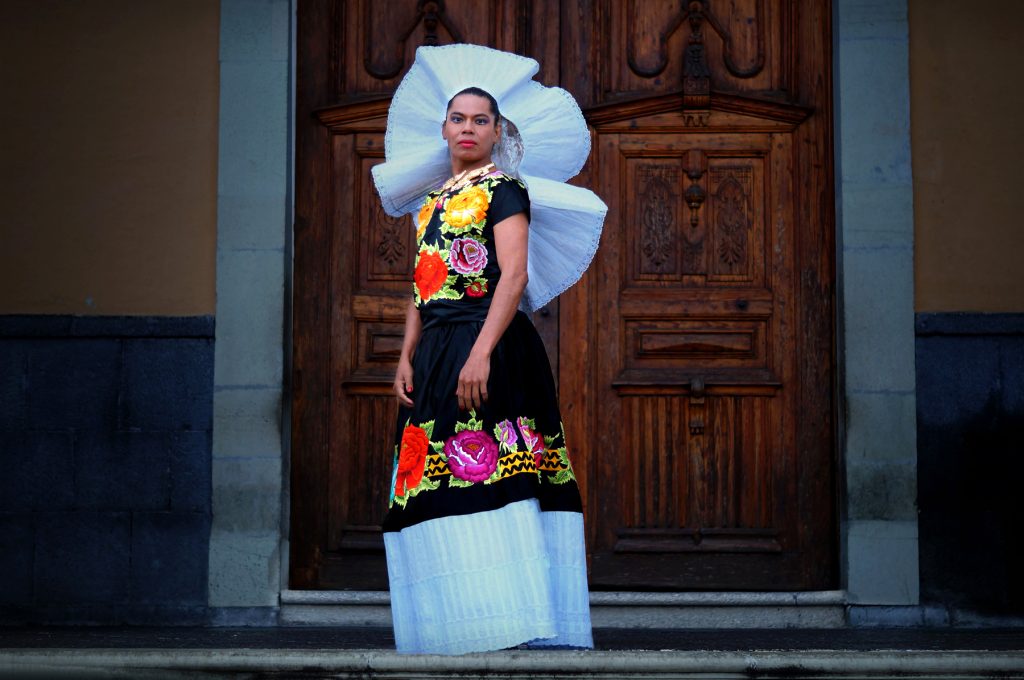
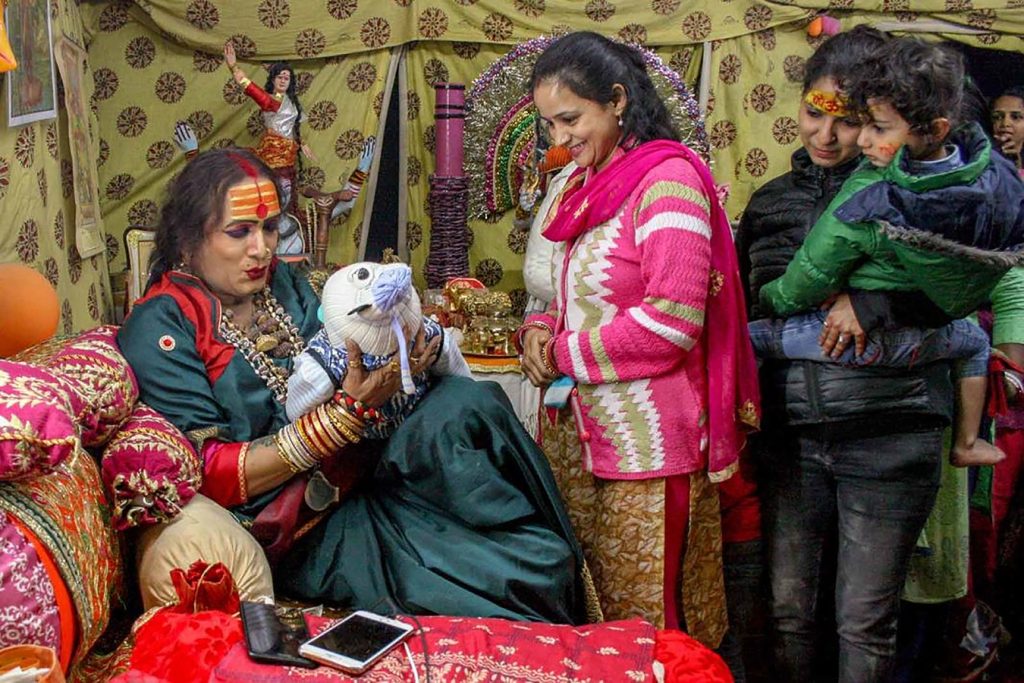
Menstrual Equity
In some cultures, menstrual blood is considered unclean or dangerous, and menstruating women are isolated or subject to various restrictions and prohibitions (often related to sex or food preparation). Anthropologist Mary Douglas studied taboos and concluded that taboo substances were thought to be “matter out of place” (Douglas 1966, 44). Douglas shows how forbidden objects or conditions produced discomfort because they transgressed conventional categories. Menstrual blood is a substance out of place. It is blood loss, but it does not indicate injury. Moreover, menstruation is hidden and connected to the dangerous states of pregnancy and childbirth. In Hebrew law, menstruation itself was considered a dangerous and contaminating exception to the purity of persons and objects. In some parts of the world, menstrual taboos keep girls and women from education and places of worship.
Activists around the world have launched social movements and other projects to make menstruation less taboo and make feminine hygiene products more easily accessible. The film Period End of Sentence, which won the 2018 Oscar for Best Documentary, illustrates one example of such an effort in India. The “Happy to Bleed” campaign is another effort to fight menstrual taboos in India. In 2023, Canada legislated that menstrual products must be available for free for employees in federally regulated public and private sector workplaces. The profile that follows describes another important project to further menstrual equity in Zimbabwe.
For more information on the menstrual equity movement, visit The Pad Project: https://thepadproject.org/
Masculinity
Contributing Author: Melanie Medeiros, SUNY Geneseo
As gender is relational, the experiences of women are tied to the gendered lives of men. Gender studies, therefore, is more than just the study of women but also includes studies of men, other genders and sexualities. The interdisciplinary study of men and masculinities dates back to the 1970s and consists of a wide field of methodological approaches and thematic foci. As the field has evolved, so have scholars’ approaches to defining masculinity. Essentialist definitions of masculinity identify certain characteristics, such as physical strength or a short temper, as intrinsically masculine and argue that masculinity is something physically or psychologically inherent in cisgender men (hereafter referred to simply as “men”)—that results in these characteristics, irrespective of social or cultural influences. Gender scholars since the 1970s have refuted essentialist notions that there are biological underpinnings to gender norms, roles, and identities that make gender universal (Fausto-Sterling 2013 [2000]). However, studies of masculinity do tend to define masculinity based on the mainstream idea of a gender binary that includes the categories of “men” and “women,” which leads to a relational definition of “masculinity” that describes it as being in contrast to “femininity,” emphasizing the perceived differences between genders, as well as within gender categories (Connell 2016; Gutmann 1997). Therefore the notion of masculinity and the study of it is more common in societies that emphasize a distinct gender binary, such as in Europe and North America since the nineteenth century (Connell 2016). In the 1990s scholarship shifted from the term masculinity (singular) toward the concept of masculinities (Connell 2005 [1995]), which acknowledges that there are many forms of masculinity and that there is gender stratification among men—not just between men and women. Conventionally, “masculinity” is an ideal of what society expects men to be and how to act, while the acknowledgment of multiple “masculinities” recognizes that there are men who may or may not aspire to or fulfill local expectations of masculine performance (Connell 2016). Connell (2016) argues, “Rather than attempting to define masculinity as an object (a natural character type, a behavioral average, a norm), we need to focus on the processes and relationships through which men and women conduct gendered lives. ‘Masculinity,’ to the extent the term can be briefly defined at all, is simultaneously a place in gender relations, the practices through which men and women engage that place in gender, and the effects of these practices in bodily experience, personality and culture” (138). In other words, masculinity is not a fixed and tangible object or archetype but a constantly negotiated gender performance that is often part of one’s gender identity and gender relations.
Gender scholars have studied masculinity among cisgender men, trans men, and cisgender men and women identifying as gay or queer (Abelson 2016; Connell 2005 [1995], 2001; Gutmann 2007 [1996]); Halberstam 2018 [1998]; Inhorn 2012; Mitchell 2015; Parker 2003; Schilt 2010). These scholars have examined a wide range of topics related to masculinities. For example, some scholars have focused on gender hierarchies and inequality between men and women and among men as well (Wade and Ferree 2019). There is a substantial body of literature on the relationship between men, masculinity, and violence, including examining men as perpetrators and victims of violence (Abelson 2016; Ellis 2016). Another topic of study is representations of men and masculinity in the media (Keith 2017; Zeglin 2016). Scholars have also been interested in understanding masculinities in relationship to kinship and parenting (Edley 2017; Keith 2017). Scholars examine masculinity in conjunction with sexuality, sexual orientation, as well as the relationship between masculinity and homophobia (Bucher 2014; Edley 2017). Ethnographic studies of masculinity highlight cross-cultural and intracultural variation in the construction and performance of masculinity (Conway-Long 1994; Ellis 2016; Gutmann 1997, 2003, 2007 [1996]; Mitchell 2015; Wentzell 2013).
Theories of Masculinities
By far the most frequently utilized theory of masculinities is Connell’s (1995) hegemonic masculinity theory (HMT). The theoretical concept of hegemony (Gramsci 1971) explains how power can function without force when a dominant social group creates collective agreement within a society about such things as behavioral norms, beliefs, and values. This collective consent naturalizes both the power and prestige of the dominant group, as well as social inequality. For example, many people in the United States believe class inequality is a natural product of human behavior rather than the outcome of our political economic system or the value of individualism. Beliefs or ideals are hegemonic when they are taken for granted and viewed as inevitable realities rather than products of society and culture and when they are supported by the dominant groups who benefit from them and by the marginalized groups who do not benefit. “Hegemony, then, means widespread consent to relations of systematic social disadvantage” (Wage and Ferree 2019, 137) often involving the “willing compliance of the oppressed” (Anderson 2016, 184). Hegemonic masculinity theory in turn argues that there are certain traits, behaviors, and discourses associated with masculinity and the performance of masculinity that are valued and rewarded by a culture or society’s dominant social groups. As a result, the performance of and practices associated with hegemonic masculinity help to legitimize power and inequality, or more specifically according to Connell—patriarchy. Therefore, hegemonic masculinity is not only a society’s ideal of manhood but part of a system of social and gender inequality that preferences certain traits, practices, and discourses over others, oppressing and marginalizing both men and women who do not meet this standard (Wage and Ferree 2019).
According to Connell (2005 [1995]) there are three categories of masculinities subsumed by the term hegemonic masculinity: complicit, subordinated, and marginalized. Individuals who exhibit the traits or practices associated with hegemonic masculinity, or who aspire to them, would be “complicit” within this gender system. Connell described men whose other social identities—particularly race and class—place them outside the dominant social groups as having “marginalized” masculinities because their position on the gender hierarchy is beneath that of the dominant group of men who more closely approximate hegemonic masculinity. Interestingly, Connell opted to distinguish sexual orientation from other forms of social identity, arguing that the masculinities of gay men were “subordinated” rather than marginalized. As such, Connell argued that heterosexuality is a key component of hegemonic masculinity, and other scholars have built from this theory to argue that hegemonic masculinity and homophobia are mutually constitutive. As one scholar observed, “Homophobia is not only a tool to enforce masculinity, but is a part of how hegemonic masculinity is constructed. Meaning, just as heterosexuality is part of ‘being a man’, so too is denying the masculinity of gay men” (Bucher 2014, 225). Hegemonic masculinity theory opened up awareness that there are many forms of masculinity, that traits and behaviors of men who do not approximate hegemonic masculinity are policed (physically and discursively) and marginalized, and thus not all men hold an equal position on the gender hierarchy (Anderson 2016; Wage and Ferree 2019). Hegemonic masculinity theory pioneered new directions in gender scholarship and continues to be one of the most widely used theoretical approaches to studying masculinities.
However, no theory is without critique. Anderson (2016) suggests that in using the concept of hegemony, HMT is problematic on the one hand because it does not grant individuals agency to question or challenge hegemonic norms and on the other because it treats hegemonic masculinity as “an archetype of masculinity” rather than “a social process.” (Anderson 2016, 183). Revisiting their theory in 2016, Connell does note that the characteristics a society or culture value and associate with ideal masculinity are constantly in flux, and therefore hegemonic masculinity “can be defined as the configuration of gender practice which embodies the currently accepted answer to the problem of the legitimacy of patriarchy which guarantees (or is taken to guarantee) the dominant position of men and the subordination of women” (Connell 2016, 139). Anderson (2016) also points out that while HMT was very useful for examining masculinities in North America in the 1980s and 1990s, it is less applicable in a contemporary North American society. They argue that since heterosexuality and the subjugation of gay or queer men is a key component of HMT, the theory is no longer relevant in a society, or among subgroups (e.g., high school students) for whom heteronormativity is no longer a hegemonic ideal. I offer a similar critique, that HMT—with its emphasis on heteronormativity—is inadequate for examining masculinity in societies where sexuality and sexual orientation are more fluid than the gay/straight binary discussed by gender scholars of North America in the late twentieth century. Therefore, valuing the contributions of HMT but recognizing its shortcomings, scholars today employ several alternative concepts, such as “mainstream,” “dominant,” and most frequently “normative” masculinities to examine the ways that certain traits, behaviors, and practices are idealized by a society, and how those ideals are constantly changing in response to social, cultural, and political economic changes.
Ethnographic studies have contributed a more nuanced approach to the study of masculinities and provide evidence showing that there can be multiple (more than three) masculinities in a given setting and that men are not necessarily aspiring toward one dominant ideal, nor are they limited to one form of masculine performance and identity. Men can aspire to a dominant or normative form of masculinity, challenge norms, or combine aspects of normative gender scripts and performances to create a hybrid form of masculinity that is unique or useful to them in a given space and time (Giddings and Hovorka 2010). For example, Gutmann describes how men in Mexico perform a multiplicity of masculinities both in the public sphere and in the home (Gutmann 2007 [1996]). Terms such as variant masculinities (Fonseca 2001; Lindisfarne 1994), emerging masculinities (Inhorn 2012), composite masculinities (Wentzell 2013), and inclusive masculinities (Anderson 2016) challenge the assumption of a fixed or “traditional” masculinity, and show that not all people subscribe to gender norms that reinforce the power of dominant groups while oppressing others.
Conclusion
In this chapter we have examined some of the key concepts that will be used throughout this book, including gender, sex, and sexuality as well as nonbinary gender expressions throughout the world. We also addressed how gender is fundamentally shaped by culture and how all gender expressions, including masculinity, must be understood in relation to one another and in the cultural context in which they occur. As you go through the chapters of the book you may wish to refer back to these concepts, using them as a guide and reference to understand the various global perspectives on gender. These key concepts will also form the foundation for the following chapter, which introduces the key perspectives used in this book. These are exciting and perhaps challenging ideas, as they address intimate parts of our own identities and worldviews.
Review Questions
- Discuss how sex, gender, and sexuality are related but also distinct concepts.
- Discuss two examples of how gender is shaped by culture.
- Identify some cross-cultural examples of nonbinary gender expressions.
- Explain how gender is relational, such as how masculinity is relational to other gender expressions.
Key Terms
biological determinism: the unfounded idea that biology is destiny and that nature, not culture, determine the abilities and practices of males and females.
cisgender: refers to individuals who identify with the sex and gender assigned to them at birth.
cultural relativism: the idea that we should seek to understand another person’s beliefs and behaviors from the perspective of their own culture and not our own.
ethnocentric/ethnocentrism: the tendency to view one’s own culture as most important and correct and as the yardstick by which to measure all other cultures.
ethnography: the in-depth study of the everyday practices and lives of a people.
gender: the ideas and expectations we attach to biological sex which can vary across time and cultures.
gender ideology: the assumptions we make about how gendered individuals should act in social life (appearance, sexual attraction, abilities, demeanor, roles, etc.).
hegemony/hegemonic: the dominance of one group over another supported by legitimating norms and ideas that normalize dominance. Using collective consent rather than force, dominant social groups maintain power and social inequalities are naturalized.
holistic/holism: the idea that the parts of a system interconnect and interact to make up the whole.
hegemonic masculinity theory (HMT): a theory developed by Connell (1995) arguing that there are certain traits, behaviors, and discourses associated with masculinity that are valued and rewarded by a culture or society’s dominant social groups and that the performance of hegemonic masculinity helps to legitimize power and inequality, or more specifically, patriarchy.
heteronormativity: a term that describes how sexuality is constructed in society and the politics around such constructions that assume everyone is heterosexual.
masculinity: the culturally specific traits, behaviors, and discourses expected of men.
matrifocal: households or family groups consisting mainly of female relatives.
patriarchy: a structure of power in which males are privileged over females.
patrilocal: a practice in which married couples share a household with or nearby the husbands’ family.
sex: refers to the biological variation among bodies based on chromosomes, gonads, sex hormones, and genitals. Bodies may fit typical definitions of ‘male’ or ‘female’ or may be intersex, presenting biological variations of sex characteristics.
third gender: gender identifications beyond the binary identifications of man or woman.
transgender: individuals who identify with a gender not assigned to them at birth.
Two-Spirit: Traditionally a Native American term referring to individuals who combined gendered activities of both men, giving them a unique status. They were considered neither men nor women but were seen as a distinct, alternative third gender.
Resources for Further Exploration
- Are Men Animals? How Modern Masculinity Sells Men Short (2019) by Matthew Gutman. Basic Books
- Masculinities under Neoliberalism. 2016. Edited by Andrea Cornwall, Frank Karioris, and Nancy Lindisfarne. London: Zed.
- Toward An Anthropological Understanding of Maleness and Violence. 2019.
- Fausto-Sterling, Anne. 2012. Sex/Gender: Biology in a Social World. New York: Taylor and Francis.
- Mukhopadhyay, Carol; Blumenfield, Tami. 2020. Chapter 10 Gender and Sexuality in Perspectives: An Open Invitation to Cultural Anthropology. 2nd ed. Arlington, VA: American Anthropological Association. https://pressbooks.pub/perspectives/
Bibliography
Abelson, Miriam J. 2016. “Negotiating Vulnerability and Fear: Rethinking the Relationship Between Violence and Contemporary Masculinity.” In Exploring Masculinities: Identity, Inequality, Continuity, and Change, edited by C. J. Pascoe and T. Bridges, 337–347. New York: Oxford University Press.
Anderson, Eric. 2016. “Inclusive Masculinities.” In Exploring Masculinities: Identity, Inequality, Continuity, and Change, edited by C. J. Pascoe and T. Bridges, 178–187. New York: Oxford University Press.
Bucher, Jacob. 2014. “But He Can’t Be Gay”: The Relationship between Masculinity and Homophobia in Father-Son Relationships. Journal of Men’s Studies 22, no. 3: 222–237.
Connell, Raewyn. 2005 [1995]. Masculinities. Cambridge, UK: Polity.
Connell, Raewyn. 2001. The Men and The Boys. Berkeley: University of California Press.
Connell, Raewyn. 2016. “The Social Organization of Masculinity.” In Exploring Masculinities: Identity, Inequality, Continuity, and Change, edited by C. J. Pascoe and T. Bridges, 136–144. New York: Oxford University Press.
Conway-Long, Don. 1994. “Ethnographies and Masculinities.” In Theorizing Masculinities, edited by H. Brod and M. Kaufman, 61–81. New York: SAGE.
Douglas, Mary. 1966. Purity and Danger: an analysis of concepts of pollution and taboo. New York: Routledge.
Edley, Nigel. 2017. Men and Masculinity: The Basics. New York: Routledge.
Ellis, Anthony. 2016. Men, Masculinities, and Violence: An Ethnographic Study. London: Routledge.
Fausto-Sterling, Anne. 2000. “The Five Sexes, Revisited.” The Sciences 40, no. 4: 18–23.
Fausto-Sterling, Anne. 2013 [2000]. “Dueling Dualisms.” In Sex, Gender and Sexuality: The New Basics, edited by A. L. Ferber, K. Holcomb and T. Wentling, 6–34. New York: Oxford University Press.
Giddings, Carla, and Alice Hovorka. 2010. “Place, Ideological Mobility and Youth Negotiations of Gender Identities in Urban Botswana.” Gender, Place & Culture 17, no. 2: 211–229.
Gutmann, Matthew. 1997. “Trafficking in Men: The Anthropology of Masculinity.” Annual Review of Anthropology 26: 385–409.
———. 2003. Changing Men and Masculinities in Latin America. Durham, NC: Duke University Press.
———. 2007 [1996]. The Meanings of Macho. Berkeley: University of California Press.
Halberstam, Jack. 2018 [1998]. Female Masculinity. Durham, NC: Duke University Press.
Hasty, Jennifer, David G. Lewis, Marjorie M. Snipes. 2022. Introduction to Anthropology. Houston, TX: OpenStax. https://openstax.org/books/introduction-anthropology/pages/12-1-sex-gender-and-sexuality-in-anthropology.
Imperato-McGinley, Julianne, Teofilo Gautier Guerrero, and Ralph Peterson. 1974. “Steroid 5α-Reductase Deficiency in Man: An Inherited Form of Male Pseudohermaphroditism.” Science 186, 4170 (December 1974): 1213–1215.
Inhorn, Marcia C. 2012. The New Arab Man: Emergent Masculinities, Technologies, and Islam in the Middle East. Princeton, NJ: Princeton University Press.
Keith, Thomas. 2017. Masculinities in Contemporary American Culture: An Intersectional Approach to the Complexities and Challenges of Male Identity. New York: Routledge.
Lindisfarne, N. 1994. “Variant Masculinities and Variant Virginities: Rethinking ‘Honor and Shame.’” In Dislocating Masculinity: Comparative Ethnographies, edited by A. Cornwall and N. Lindisfarme, 82–96. London: Routledge.
Lorber, Judith. [2005] 2013. “A World without Gender: Making the Revolution.” In Sex, Gender and Sexuality: The New Basics, edited by A. L. Ferber, K. Holcomb and T. Wentling, 401–409. New York: Oxford University Press.
Mirande, Alfredo. 2015. “Hombres Mujeres: An Indigenous Third Gender.” Men and Masculinities, 1–27. Los Angeles: SAGE.
Mukhopadhyay, Carol; Blumenfield, Tami. 2020. Chapter 10 Gender and Sexuality in Perspectives: An Open Invitation to Cultural Anthropology. 2nd ed. Arlington, VA: American Anthropological Association. https://pressbooks.pub/perspectives/
Nelson, Katie; Braff, Lara. 2020. Chapter 1 Introduction to Anthropology in Perspectives: An Open Invitation to Cultural Anthropology. 2nd ed. Arlington, VA: American Anthropological Association. https://pressbooks.pub/perspectives/
Parker, Richard. 2003. “Changing Sexualities: Masculinity and Male Homosexuality in Brazil.” In Changing Men and Masculinities in Latin America, edited by M. C. Gutmann, 307–332. Durham, NC: Duke University Press.
Petersen, Alan. 2016. “Research on Men and Masculinities: Some Implications of Recent Theory for Future Work.” In Exploring Masculinities: Identity, Inequality, Continuity, and Change, edited by C. J. Pascoe and T. Bridges, 337–347. New York: Oxford University Press.
Schilt, Kristen. 2010. Just One of the Guys? Transgender Men and the Persistence of Gender Inequality. Chicago and London: University of Chicago Press.
Shook, Beth, Katie Nelson, Kelsie Aguilera, and Lara Braff. 2019. Explorations: An Open Invitation to Biological Anthropology. Arlington, VA: American Anthropological Association.
van Anders, S. M., J. Steiger, and K. L. Goldey. 2015. Effects of gendered behavior on testosterone in women and men. Proceedings of the National Academy of Sciences of the United States of America 112, no. 45, 13805–13810. https://doi.org/10.1073/pnas.1509591112
Credits
Some sections of this chapter were adapted from work by Deborah Amory and “Gender and Sexuality,” chapter 10 by Carol C. Mukhopadhyay and Tami Blumenfield (with Susan Harper and Abby Gondek) in Perspectives: An Open Introduction to Cultural Anthropology, ed. Nina Brown, Thomas McIlwraith, and Laura Tubelle de González, 2nd ed. (Washington, DC: American Anthropological Association, 2020); and Hasty, Jennifer, David G. Lewis, Marjorie M. Snipes. 2022. Introduction to Anthropology. Houston, TX: OpenStax. https://openstax.org/books/introduction-anthropology/pages/12-1-sex-gender-and-sexuality-in-anthropology.
Refers to the biological variation among bodies based on chromosomes, gonads, sex hormones, and genitals. Bodies may fit typical definitions of ‘male’ or ‘female’ or may be intersex, presenting biological variations of sex characteristics.
The ideas and expectations we attach to biological sex which can vary across time and cultures.
The assumptions we make about how gendered individuals should act in social life (appearance, sexual attraction, abilities, demeanor, roles, etc.)
the culturally specific traits, behaviors, and discourses expected of men.
the idea that the parts of a system interconnect and interact to make up the whole.
the in-depth study of the everyday practices and lives of a people.
the idea that we should seek to understand another person’s beliefs and behaviors from the perspective of their own culture and not our own.
the tendency to view one’s own culture as most important and correct and as the yardstick by which to measure all other cultures.
Individuals who identify with a gender not assigned to them at birth.
Gender identifications beyond the binary identifications of man or woman.
Patriarchy describes a society with a male-dominated political and authority structure and an ideology that privileges males over females in domestic and public spheres.
a Native American term referring to individuals who combined gendered activities of both men, giving them a unique status. They were considered neither men nor women but were seen as a distinct, alternative third gender.
refers to individuals who identify with the sex and gender assigned to them at birth.
a theory developed by Connell (1995) arguing that there are certain traits, behaviors, and discourses associated with masculinity that are valued and rewarded by a culture or society’s dominant social groups and that the performance of hegemonic masculinity helps to legitimize power and inequality, or more specifically, patriarchy.
the dominance of one group over another supported by legitimating norms and ideas that normalize dominance. Using collective consent rather than force, dominant social groups maintain power and social inequalities are naturalized.
a term that describes how sexuality is constructed in society and the politics around such constructions that assume everyone is heterosexual.







